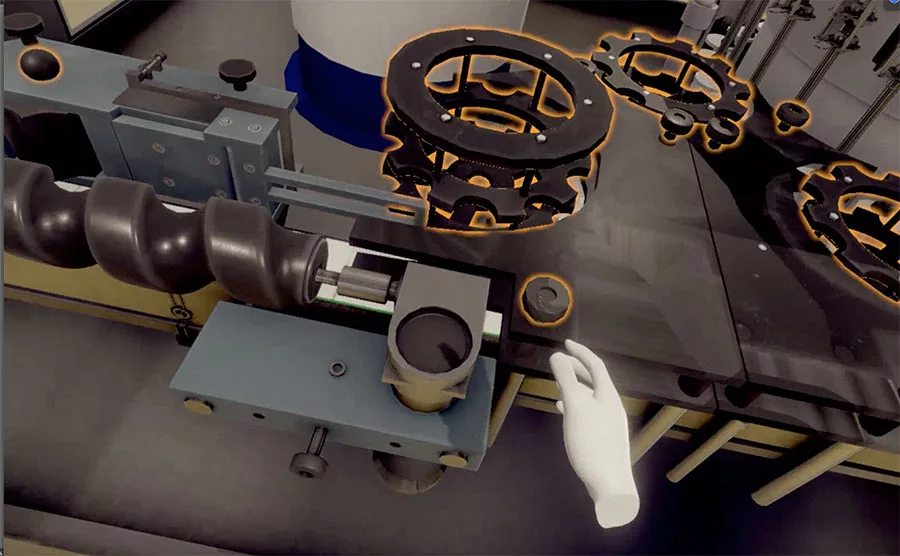Il est essentiel de préciser que notre propos ne concerne ni la simulation architecturale des travaux neufs, ni la simulation des méthodes industrielles. We will instead focus on an immersive simulation approach, aiming to optimize the overall efficiency of an organization through research and comparison of configurations.
At AUDACE, simulation plays a central role in the field of training engineering. It offers remarkable visual and demonstrative power, simplifying mediation and facilitating the understanding of operating modes, whether it’s a machine or technical gestures. Its use stands out particularly during different pedagogical phases: discovery, practice, confrontation, evaluation.
Formative simulation offers considerable advantages, particularly among operational audiences who appreciate realism and pragmatism. By bridging the gap between theory and practice, it allows for better assimilation of knowledge. Immersed in the faithful reenactment of their work environment, the learner becomes an active participant in their training, moving away from the passive role of a traditional classroom setting. Constant interactions and scene fidelity contribute to enhancing memorization, concentration, and engagement.
La simulation pour découvrir son environnement de travail
VR simulation is a fantastic tool for an initial contact with the real work environment. Whether it’s to facilitate a recruitment session, onboard new employees or temporary workers, or promote internal team versatility.
In virtual reality, one can safely explore an industrial site spanning several thousand square meters within a limited training area. Virtual reconstitution allows one to become familiar with the layout of the workshops, where they can freely move around and start the machines.
THE F2A NETWORK CASE
This type of device is perfectly exemplified by the bottling line simulator developed for the F2A Network (Network of Vocational High Schools in the Agri-food Industries). It was initiated to address the growing challenges faced by students in accessing production sites for training purposes. Learners can experience the complete bottling process of a juice on a production line, including preparation, configuration, adjustments, and monitoring of production indicators. This way, they are introduced to maintenance interventions as well. Les apprenants étant des étudiants, AUDACE a réalisé des bornes interactives équipées de casques de réalité virtuelle. Each student takes turns wearing the headset while the others observe their actions on the kiosk screen. The trainer, on the other hand, guides and provides commentary.
DIGITAL TWIN IMAGES OF A PRODUCTION LINE IN A BREWERY – CLIENT: F2A NETWORK (10 PROFESSIONAL HIGH SCHOOLS OF THE NATIONAL EDUCATION)
THE RHOB CASE (ARCELORMITTAL)
ARCELOR MITTAL was opening a new steel production unit dedicated to steel processing, identified under the name RHOB. As the investment required a swift implementation after the completion of construction, it was necessary to simultaneously train the staff in their future work environment and the tools present there, prior to the actual launch. AUDACE carried out a hyper realistic simulation designed in advance of construction and incorporating all efficiency criteria. : topography and circulation within the future site, operation of tools, process principles, first-level intervention, equipment management, compliance with standards, protocols, and safety.
Simulation for practice and training.
Repetition is always virtuous in pedagogy, provided that it brings together factors of realism conducive to faithful practice. Workshops are rarely conducive environments for training. Dangers, noise, machinery, and vehicle traffic limit trainers’ ability to initiate young operators in workshops. For these novices, simulation is the concrete solution that meets the expectations of hands-on practice and manipulation.
Simulation is undeniably ideal for repeating gestures as many times as necessary and thus making them safe and precise. It also makes sense to use simulation for preparing rare operations that involve a high level of risk. It allows for improving performance and versatility according to expected standards, maintaining one’s workstation, and dealing with complex breakdown situations.
Simulation for confronting risks.
Risky work situations can be divided into two distinct categories:
- The first category consists of production situations during which employees may be exposed to hazards related to the environment (equipment, energy flows, machinery, etc.). These are fortuitous cases that are typically protected against by work organization and personal protective equipment.
- The second category consists of operators performing interventions that clearly pose a identified danger to their health. It involves individually and voluntarily exposing oneself in a measured manner to a danger for the sake of collective safety gain. For example, by exposing oneself to the dangers of fire in order to save installations or individuals.
For both categories, simulation will allow the recreation of conditions exposing individuals to risks. The learner will then be able to confront situations that require their vigilance, reasoning, compliance, as well as common sense.
For simulations of interventions in hostile environments (virology, chemistry, radioactivity, etc.), the benefits of simulation are evident. It should be noted that training in hazardous environments is the only true tool for evaluating the operational skills of an operator.
AUDACE has developed numerous simulators for confronting known or unknown risks. Fire extinguishing simulator in virtual reality, industrial risk discovery school in augmented reality, simulation of intervention in a radioactive environment…
ORANO GROUP CASE
The ORANO Group has been collaborating with the AUDACE teams for 12 years, resulting in the production of over fifty projects in the nuclear field. Recently, AUDACE has developed a simulator called “JUMPER.” This device offers an intervention experience in the heart of a highly radioactive confined space.
The learner practices “jumping,” intervening, and exiting a steam generator to replace a “vital” component called the “tape.” The learner must perform their work according to the expected standard while minimizing their exposure to radiation. Very anxiety-inducing, the virtual reality simulation recreates both the feeling of claustrophobia, the manipulation with limited light, and the imperative of execution speed that the collaborator must demonstrate.
The program measures everything the learner accomplishes and compares it to pre-recorded standards. The learner is thus continuously evaluated through their choices, actions, reaction time, and achievement of scores. The simulation can then compare the learner’s results to the initial expectations.
Depending on the types of simulation, the program can provide immediate feedback on the quality of task performance. A detailed analysis of actions can be provided as an assessment of the immersion experience.
The trainer can also choose to make the experience more challenging by changing the level (beginner, intermediate, expert) or introducing random events. Another solution is to let an AI (Artificial Intelligence) automatically regulate the metrics of the experience based on criteria predefined by the trainer.
The simulation experience can be created solely for the purpose of evaluating a candidate preparing for diploma exams or applying for a job.
BRIDGESTONE CASE
The BRIDGESTONE Group is deploying a tire manufacturing simulator in Europe to accommodate new entrants. Designed by AUDACE, this virtual reality simulator offers a digital twin of the tire mounting machine.
The objective is first to assess the individual’s ability to reproduce a gesture and then execute it at a precise pace. This tool no longer requires the use of a real machine, consumes minimal raw materials, and almost no energy. The program analyzes in detail what the learner accomplishes, allowing the trainer to focus solely on the debriefing phases.
In all situations requiring repetition, repetitiveness, rarity, or risk, simulation is an operational and competitive solution. Simulation helps solidify knowledge and skills, allowing for training and evaluation of competencies. In a context where the cost of energy and raw materials is skyrocketing, learning on a simulator is an economical and ecological 4.0 solution. A fantastic tool for attracting young people and a formidable tool for continuous improvement for the more experienced individuals.

